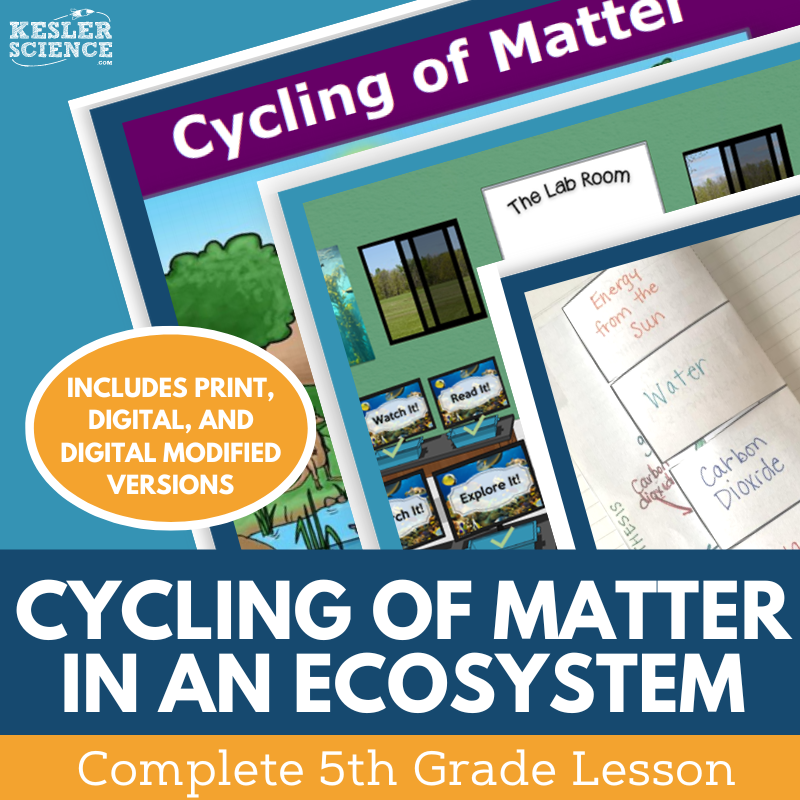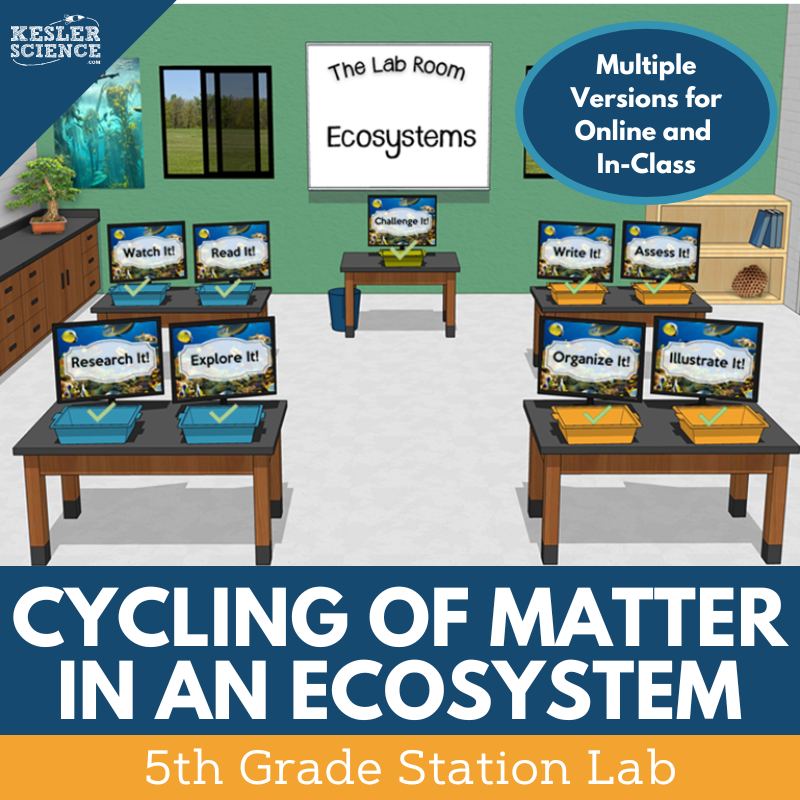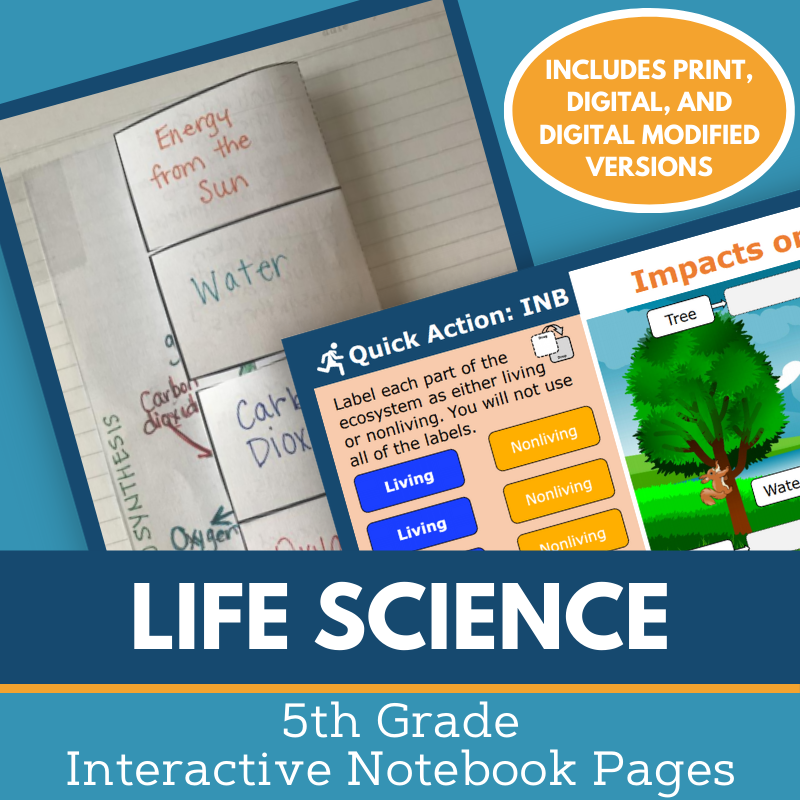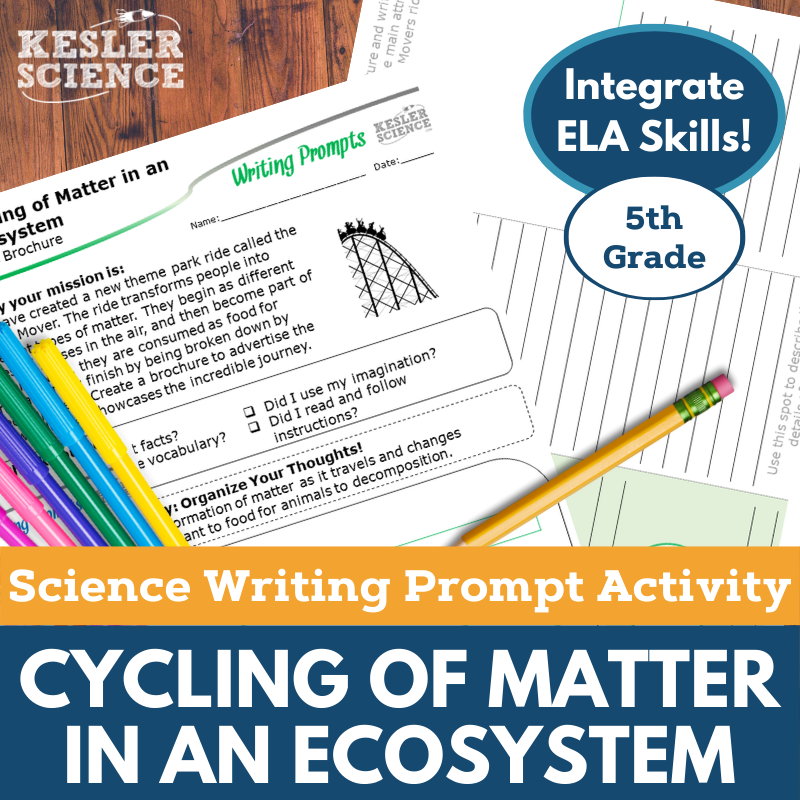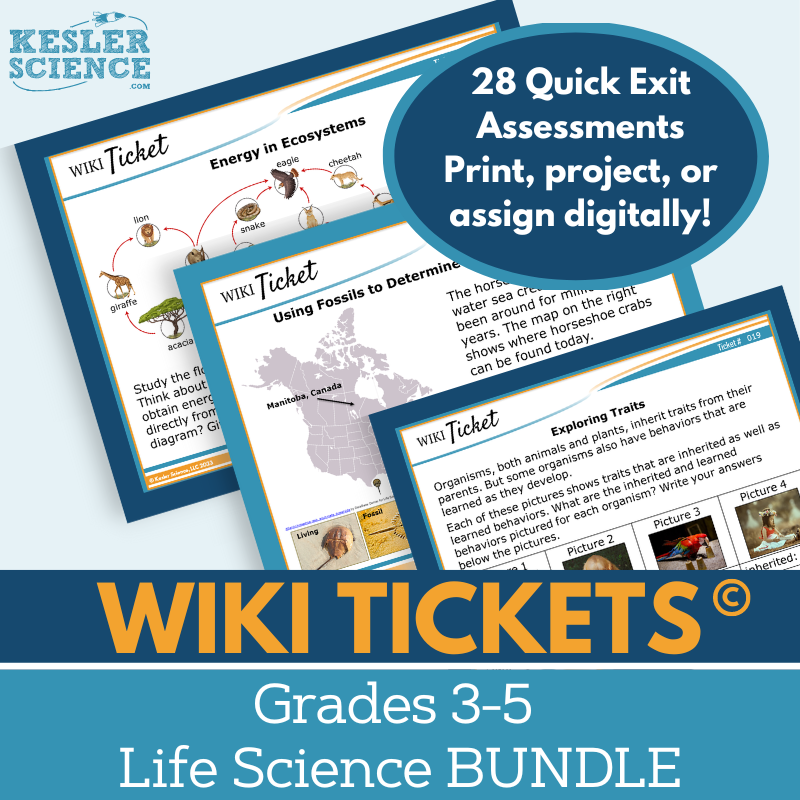Cycling of Matter Activities for 5th Grade Science
Help students explore the cycling of matter in ecosystems with this engaging 5E lesson. Through interactive activities, students investigate how living things obtain energy and nutrients and the role of plants in a food web. The resources below will give students a comprehensive understanding of the cycling of matter. All of the following materials are also included in the Kesler Science Membership.
The Kesler Science Cycling of Matter in an Ecosystem 5E Lesson is a comprehensive, low-prep unit designed for engaging, student-led learning. It includes editable presentations, worksheets, choice projects, and assessments, with differentiation to support diverse learners. The lesson follows the 5E Model, integrating multimodal exploration and interactive activities to enhance understanding.
Students engage with essential questions about how living things obtain energy and nutrients and the role of plants in a food web. The Exploration phase features a student-led station lab with nine stations, offering hands-on experiments, reading passages in English and Spanish, research tasks, videos, card sorts, writing prompts, and drawing activities. A bonus extension station challenges advanced learners. Explanation includes editable PowerPoints, interactive notebooks, and structured note-taking templates. Elaboration allows students to extend learning through choice projects, while Evaluation includes STAAR 2.0-aligned assessments, review questions, and worksheets.
The lesson is fully adaptable for digital and in-person instruction, with materials available in multiple formats, including Spanish translations. Designed for maximum flexibility, it ensures an engaging and comprehensive approach to teaching the cycling of matter in ecosystems.
The Kesler Science Cycling of Matter in an Ecosystem 5E Lesson is a comprehensive, low-prep unit designed for engaging, student-led learning. It includes editable presentations, worksheets, choice projects, and assessments, with differentiation to support diverse learners. The lesson follows the 5E Model, integrating multimodal exploration and interactive activities to enhance understanding.
Students engage with essential questions about how living things obtain energy and nutrients and the role of plants in a food web. The Exploration phase features a student-led station lab with nine stations, offering hands-on experiments, reading passages in English and Spanish, research tasks, videos, card sorts, writing prompts, and drawing activities. A bonus extension station challenges advanced learners. Explanation includes editable PowerPoints, interactive notebooks, and structured note-taking templates. Elaboration allows students to extend learning through choice projects, while Evaluation includes STAAR 2.0-aligned assessments, review questions, and worksheets.
The lesson is fully adaptable for digital and in-person instruction, with materials available in multiple formats, including Spanish translations. Designed for maximum flexibility, it ensures an engaging and comprehensive approach to teaching the cycling of matter in ecosystems.
Engage your 5th-grade students with this student-led station lab on energy in ecosystems. Designed for in-class or virtual learning, this modular lesson allows students to explore producers, consumers, and energy sources in ecosystems through nine interactive stations.
Students encounter new concepts through hands-on demonstrations, research, reading passages, and videos. They demonstrate their understanding by organizing information, illustrating models, writing responses, and completing assessments. A bonus challenge station provides extension activities for early finishers.
This differentiated, low-prep resource fosters active learning and critical thinking while giving students control over their learning experience.
Engage your 5th-grade students with this student-led station lab on energy in ecosystems. Designed for in-class or virtual learning, this modular lesson allows students to explore producers, consumers, and energy sources in ecosystems through nine interactive stations.
Students encounter new concepts through hands-on demonstrations, research, reading passages, and videos. They demonstrate their understanding by organizing information, illustrating models, writing responses, and completing assessments. A bonus challenge station provides extension activities for early finishers.
This differentiated, low-prep resource fosters active learning and critical thinking while giving students control over their learning experience.
The Cycling of Matter in an Ecosystem Student Choice Projects lesson allows 5th-grade students to select a project that aligns with their preferred output style. A project page outlines six student-led options plus a “design your own” project, with an editable rubric for teacher, peer, or self-assessment.
These flexible, multimodal projects provide creative ways for students to demonstrate their understanding. Two versions of the project page support differentiation, with modified options for students needing remediation and challenge opportunities for advanced learners. Teachers can adjust the rubric to fit their grading needs.
The projects require standard classroom supplies such as paper, markers, and scissors, though many can be completed digitally. Some crafting materials may be helpful for model-building.
The Cycling of Matter in an Ecosystem Student Choice Projects lesson allows 5th-grade students to select a project that aligns with their preferred output style. A project page outlines six student-led options plus a “design your own” project, with an editable rubric for teacher, peer, or self-assessment.
These flexible, multimodal projects provide creative ways for students to demonstrate their understanding. Two versions of the project page support differentiation, with modified options for students needing remediation and challenge opportunities for advanced learners. Teachers can adjust the rubric to fit their grading needs.
The projects require standard classroom supplies such as paper, markers, and scissors, though many can be completed digitally. Some crafting materials may be helpful for model-building.
The 5th Grade Life Science Interactive Notebook is a comprehensive resource designed to engage students in key life science concepts through hands-on activities. Available in both print and digital formats, this interactive tool is perfect for traditional classrooms, 1:1 learning environments, and distance learning. The digital version includes a unique PowerPoint that can be uploaded to Google Slides and integrated with platforms like MS Teams, Schoology, and Canvas. It features reflection pages, space for student notes, a teacher answer key, and a modified version for students with accommodations.
The paper version includes blank and pre-filled interactive notebook templates, along with color photos demonstrating their use. Covering essential life science topics such as plant growth, cycling of matter in an ecosystem, living vs. nonliving, energy and impacts on ecosystems, fossil evidence, structures and behaviors, and inherited traits and learned behaviors, this resource helps students develop a deeper understanding of key scientific principles.
These interactive notebook templates are also included in the Kesler Science 5E Lessons, which offer a complete instructional package with presentations, notes, homework, student projects, station labs, assessments, and engagement activities.
The 5th Grade Life Science Interactive Notebook is a comprehensive resource designed to engage students in key life science concepts through hands-on activities. Available in both print and digital formats, this interactive tool is perfect for traditional classrooms, 1:1 learning environments, and distance learning. The digital version includes a unique PowerPoint that can be uploaded to Google Slides and integrated with platforms like MS Teams, Schoology, and Canvas. It features reflection pages, space for student notes, a teacher answer key, and a modified version for students with accommodations.
The paper version includes blank and pre-filled interactive notebook templates, along with color photos demonstrating their use. Covering essential life science topics such as plant growth, cycling of matter in an ecosystem, living vs. nonliving, energy and impacts on ecosystems, fossil evidence, structures and behaviors, and inherited traits and learned behaviors, this resource helps students develop a deeper understanding of key scientific principles.
These interactive notebook templates are also included in the Kesler Science 5E Lessons, which offer a complete instructional package with presentations, notes, homework, student projects, station labs, assessments, and engagement activities.
The Cycling of Matter in an Ecosystem science writing activity engages 5th-grade students in a fun and interactive way to demonstrate their life science knowledge. Using a ride brochure story model, this print-or-digital exercise encourages creative writing while reinforcing key science concepts. Designed for both in-person and virtual learning, the activity keeps students engaged inside or outside the classroom.
Aligned with NGSS 5-LS2-1, this student-centered writing prompt helps students develop a model to describe the movement of matter among plants, animals, decomposers, and the environment. It includes teacher directions with rubrics, projection and print handouts, and a digital interactive version in PowerPoint and Google Slides. The resource can be used as a cross-curricular activity, pre-test assessment, student choice project, early finisher task, extra credit, make-up work, or differentiation exercise. Ideal for display on bulletin boards or as part of a student anthology, this engaging writing prompt supports science literacy and exploration.
The Cycling of Matter in an Ecosystem science writing activity engages 5th-grade students in a fun and interactive way to demonstrate their life science knowledge. Using a ride brochure story model, this print-or-digital exercise encourages creative writing while reinforcing key science concepts. Designed for both in-person and virtual learning, the activity keeps students engaged inside or outside the classroom.
Aligned with NGSS 5-LS2-1, this student-centered writing prompt helps students develop a model to describe the movement of matter among plants, animals, decomposers, and the environment. It includes teacher directions with rubrics, projection and print handouts, and a digital interactive version in PowerPoint and Google Slides. The resource can be used as a cross-curricular activity, pre-test assessment, student choice project, early finisher task, extra credit, make-up work, or differentiation exercise. Ideal for display on bulletin boards or as part of a student anthology, this engaging writing prompt supports science literacy and exploration.
The WIKI Tickets© Life Science Set provides engaging, flexible formative assessments for 3rd–5th grade science. This set includes 28 assessments, each available in five formats: a full-screen display for projection, three print handouts in different sizes, and a digital interactive version compatible with PowerPoint and Google Slides.
Aligned with NGSS and TEKS standards, these assessments cover key topics such as cycling of matter, ecosystem changes, food webs, inherited traits, fossil evidence, and the structure and function of living organisms. Some standards have multiple tickets, ensuring comprehensive coverage. A Table of Contents file is included to show standard alignment.
WIKI Tickets© can be used in both in-person and virtual learning settings. They work as exit tickets, bellringers, or quick assessments to gauge student understanding. Teachers can project an assessment, provide printed copies, or assign the digital version for remote or 1:1 learning. These vibrant, engaging tools make assessing student progress simple and effective.
The WIKI Tickets© Life Science Set provides engaging, flexible formative assessments for 3rd–5th grade science. This set includes 28 assessments, each available in five formats: a full-screen display for projection, three print handouts in different sizes, and a digital interactive version compatible with PowerPoint and Google Slides.
Aligned with NGSS and TEKS standards, these assessments cover key topics such as cycling of matter, ecosystem changes, food webs, inherited traits, fossil evidence, and the structure and function of living organisms. Some standards have multiple tickets, ensuring comprehensive coverage. A Table of Contents file is included to show standard alignment.
WIKI Tickets© can be used in both in-person and virtual learning settings. They work as exit tickets, bellringers, or quick assessments to gauge student understanding. Teachers can project an assessment, provide printed copies, or assign the digital version for remote or 1:1 learning. These vibrant, engaging tools make assessing student progress simple and effective.
Year-Round Resources
These year-round activities will increase your students' understanding of many middle school science topics. All of these activities are also included in the Kesler Science Membership.
Visual Data & Graphing
You're not alone if your students struggle with understanding graphs, charts, and tables. It's a skill that takes an enormous amount of practice. This resource will help students build a strong foundation in analyzing data and creating their own data visualizations.
Bell Ringers and Warm-Ups
These middle school science bell ringers are an excellent way to engage your students as soon as they walk into your classroom. This comprehensive FULL YEAR resource includes everything you need to start off each science class with an interesting warm-up activity.
Review Board Games
Each game board has been carefully designed to keep students engaged. There are 10 different action spaces on each board and dozens of question cards. All of the actions are related to science concepts and keep the students motivated throughout the game.
Each game is ready to play. Simply print out the board and the cards and let the students enjoy reviewing nine different units.
Essential Questions and Standards
Below are the essential questions and standards associated with the lessons and activities included in the cycling of matter unit. This topic is only one of more than 100 middle school science topics included in the Kesler Science Membership.
-
How do living things get the energy and nutrients they need to survive?
-
What role do plants play in a food web?
-
NGSS - 5-LS2-1 Cycling of Matter
Kesler Science Membership
Imagine never having to search for another middle school science lesson again. The membership gives you access to ALL of the Kesler Science products in one place (Yes, including everything above).
Say goodbye to long hours of lesson prep.

